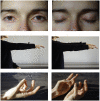The Role of Continuous Theta Burst TMS in the Neurorehabilitation of Subacute Stroke Patients: A Placebo-Controlled Study
- PMID: 34803887
- PMCID: PMC8599133
- DOI: 10.3389/fneur.2021.749798
The Role of Continuous Theta Burst TMS in the Neurorehabilitation of Subacute Stroke Patients: A Placebo-Controlled Study
Abstract
Objectives: Transcranial magnetic stimulation, in particular continuous theta burst (cTBS), has been proposed for stroke rehabilitation, based on the concept that inhibition of the healthy hemisphere helps promote the recovery of the lesioned one. We aimed to study its effects on cortical excitability, oscillatory patterns, and motor function, the main aim being to identify potentially beneficial neurophysiological effects. Materials and Methods: We applied randomized real or placebo stimulation over the unaffected primary motor cortex of 10 subacute (7 ± 3 days) post-stroke patients. Neurophysiological measurements were performed using electroencephalography and electromyography. Motor function was assessed with the Wolf Motor Function Test. We performed a repeated measure study with the recordings taken pre-, post-cTBS, and at 3 months' follow-up. Results: We investigated changes in motor rhythms during arm elevation and thumb opposition tasks and found significant changes in beta power of the affected thumb's opposition, specifically after real cTBS. Our results are consistent with an excitatory response (increase in event-related desynchronization) in the sensorimotor cortical areas of the affected hemisphere, after stimulation. Neither peak-to-peak amplitude of motor-evoked potentials nor motor performance were significantly altered. Conclusions: Consistently with the theoretical prediction, this contralateral inhibitory stimulation paradigm changes neurophysiology, leading to a significant excitatory impact on the cortical oscillatory patterns of the contralateral hemisphere. These proof-of-concept results provide evidence for the potential role of continuous TBS in the neurorehabilitation of post-stroke patients. We suggest that these changes in ERS/ERD patterns should be further explored in future phase IIb/phase III clinical trials, in larger samples of poststroke patients.
Keywords: brain oscillations; continuous theta burst stimulation; neurophysiology; neurorehabilitation; stroke; transcranial magnetic stimulation.
Copyright © 2021 Dionísio, Gouveia, Castelhano, Duarte, Santo, Sargento-Freitas, Duecker and Castelo-Branco.
Conflict of interest statement
The authors declare that the research was conducted in the absence of any commercial or financial relationships that could be construed as a potential conflict of interest.
Figures





Similar articles
-
Continuous theta burst stimulation increases contralateral mu and beta rhythms with arm elevation: implications for neurorehabilitation.J Neural Transm (Vienna). 2020 Jan;127(1):17-25. doi: 10.1007/s00702-019-02117-6. Epub 2019 Dec 16. J Neural Transm (Vienna). 2020. PMID: 31844983
-
Effects of Theta Burst Stimulation on Suprahyoid Motor Cortex Excitability in Healthy Subjects.Brain Stimul. 2017 Jan-Feb;10(1):91-98. doi: 10.1016/j.brs.2016.08.011. Epub 2016 Aug 24. Brain Stimul. 2017. PMID: 27692927
-
Long lasting modulation of cortical oscillations after continuous theta burst transcranial magnetic stimulation.PLoS One. 2012;7(4):e35080. doi: 10.1371/journal.pone.0035080. Epub 2012 Apr 4. PLoS One. 2012. PMID: 22496893 Free PMC article. Clinical Trial.
-
Toward the establishment of neurophysiological indicators for neuropsychiatric disorders using transcranial magnetic stimulation-evoked potentials: A systematic review.Psychiatry Clin Neurosci. 2020 Jan;74(1):12-34. doi: 10.1111/pcn.12936. Epub 2019 Nov 2. Psychiatry Clin Neurosci. 2020. PMID: 31587446
-
Efficacy and Time Course of Theta Burst Stimulation in Healthy Humans.Brain Stimul. 2015 Jul-Aug;8(4):685-92. doi: 10.1016/j.brs.2015.03.004. Epub 2015 Mar 26. Brain Stimul. 2015. PMID: 26014214 Review.
Cited by
-
Effects of repetitive transcranial magnetic stimulation on lower extremity motor function and optimal parameters in stroke patients with different stages of stroke: a systematic evaluation and meta-analysis.Front Neurol. 2024 Jul 26;15:1372159. doi: 10.3389/fneur.2024.1372159. eCollection 2024. Front Neurol. 2024. PMID: 39131051 Free PMC article.
-
Modulation of cerebral cortex activity by acupuncture combined with continuous theta-burst stimulation in post-stroke upper limb spasticity: an fNIRS study.Front Neurol. 2025 Jun 2;16:1542489. doi: 10.3389/fneur.2025.1542489. eCollection 2025. Front Neurol. 2025. PMID: 40529436 Free PMC article.
-
Theta-burst stimulation as a therapeutic tool in neurological pathology: a systematic review.Neurol Sci. 2024 Mar;45(3):911-940. doi: 10.1007/s10072-023-07144-6. Epub 2023 Oct 26. Neurol Sci. 2024. PMID: 37882997
-
Current evidence, clinical applications, and future directions of transcranial magnetic stimulation as a treatment for ischemic stroke.Front Neurosci. 2023 Jul 18;17:1177283. doi: 10.3389/fnins.2023.1177283. eCollection 2023. Front Neurosci. 2023. PMID: 37534033 Free PMC article. Review.
-
The role of brain oscillations in post-stroke motor recovery: An overview.Front Syst Neurosci. 2022 Jul 29;16:947421. doi: 10.3389/fnsys.2022.947421. eCollection 2022. Front Syst Neurosci. 2022. PMID: 35965998 Free PMC article. Review.
References
LinkOut - more resources
Full Text Sources
Miscellaneous

